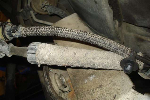Todd
Active Member
- Joined
- February 9, 1999
- Messages
- 96
- Reaction score
- 0
- City, State
- Southwest MO
- Year, Model & Trim Level
- 93 XLT (Sold)
I was in Springfield, MO this past weekend and finally got to stop by a Pep Boys. I will tell you this, I wish we had one here in St. Louis, MO. They carry about 10x more than AutoZone, etc.
Anyway, I picked up a bottle of Redline's Water Wetter. Boy does that stuff work! It is not a half temp gauge difference or that, but it is a noticeable change. The needle is a little more stable and it appears to be a "letter" lower(which boils down to at least a 5 degree difference or so). Hey for 5 or 6 bucks a bottle, you can't beat it!
I would definitely recommend it if you have any type of problems with heat and your engine!
Take care everyone and happy exploring!
------------------
Todd Metzger
tmetz@umr.edu
'Off-Road and More!'
93 "Ford X 4" XLT
Anyway, I picked up a bottle of Redline's Water Wetter. Boy does that stuff work! It is not a half temp gauge difference or that, but it is a noticeable change. The needle is a little more stable and it appears to be a "letter" lower(which boils down to at least a 5 degree difference or so). Hey for 5 or 6 bucks a bottle, you can't beat it!
I would definitely recommend it if you have any type of problems with heat and your engine!
Take care everyone and happy exploring!
------------------
Todd Metzger
tmetz@umr.edu
'Off-Road and More!'
93 "Ford X 4" XLT










